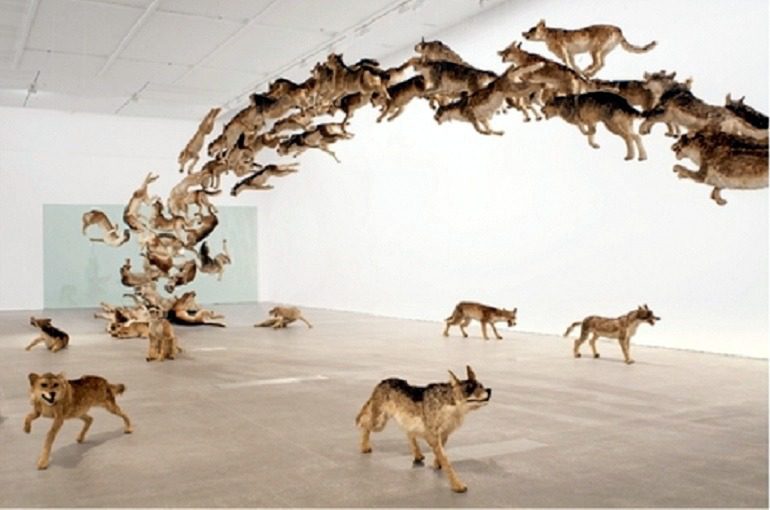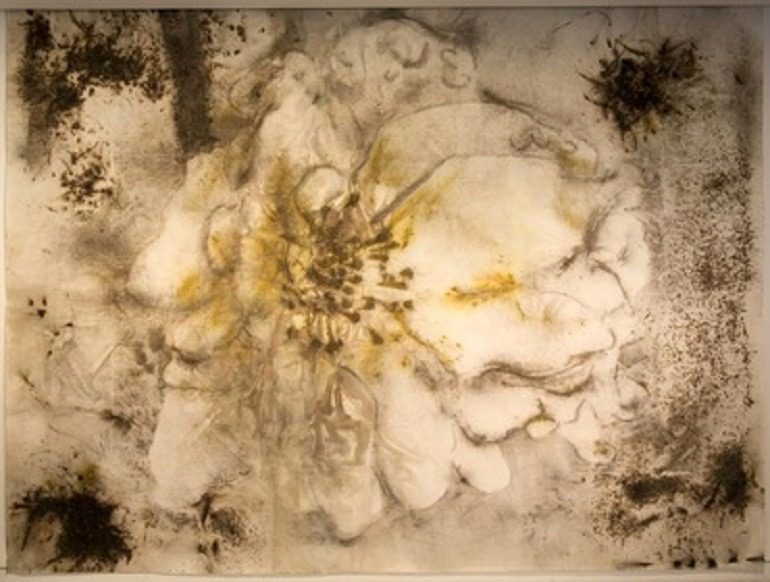ART & DESIGN
Cai Guo-Qiang, Summer, gunpowder drawing on porcelain as part of installation Spring, Summer, Fall, Winter, Power Station of Art, Shanghai, 2014. Photo: Zhang Feiyu. Image courtesy Cai Studio
ART REVIEW
Cai Guo-Qiang art at the Yokohama Museum of Art in Japan Shows the endless possibilities of art

Cai Guo-Qiang, Head On, (2006), The Deutsche Bank Collection. Photo: Jon Linkins. Image courtesy of Queensland Art Gallery and Gallery of Modern Art
JAPAN- An exhibition by Cai Guo-Qiang, one of the leading Chinese contemporary artists has opened at the Yokohama Museum of Art. Titled There and Back Again, this is the first large-scale solo exhibition of the artist to be held in Japan in the last seven years.
For Cai Guo-Qiang, the show is a form of homecoming because it reinforces his professional ties to Japan. To prepare for the show, Cai embarked on an expedition, researching Yokohama’s local history and the important cultural figures that bear relevance to his own background. The figures include Okakura Tenshin (also known as Kakuzō), a Japanese writer, and a critic. He contributed to the development of arts in Japan. Chiefly remembered today as the author of The Book of Tea, Okakura, like Cai Guo-Qiang, had multiple cultural ties to China, Japan, and the United States.
One of the major works in this exhibition is Nighttime Sakura. Created specifically for this show, this is the largest gunpowder drawing by the artist to date. Created in collaboration with students of various art colleges, Nighttime Sakura celebrates the significance of cherry blossom in Japanese culture.
Japanese Vines
Continuing with the theme of the flower is Japanese Vines. The installation consists of hundreds of Japanese morning glories suspended from the ceiling. The life-like looking flower installation consists of terracotta ceramics, gunpowder, steel bars, and wire. It drops from the ceiling in a way that captivates the audience.
Besides the new works, several seminal pieces by the artist are also on display. One of them is Head On (2006). The visually staggering installation consists of 99 life-sized stuffed wolves crashing headlong into a glass wall. The installation is on display for the first time in Japan. Cai Guo-Qiang’s Head On has been a major source of fascination for art audiences since the show opened.
ART AUCTION NEWS | READ ALSO: China’s Eccentric Art Collector Liu Yiqian Boosts Asia’s Art Market
The momentum and the relentlessness of the wolves as they forcefully crash against the transparent barrier makes the piece dramatic. Inspired by Berlin and its history, Head On was conceived for the Deutsche Bank Collection. For the artist, however, Head On has a universal application as it reveals the Machiavellian and uncompromising human tendencies.
Spring, Summer, Fall, Winter (2014), a suite of four gun powder drawings on porcelain, each measuring 3m long by 2.4 m wide, pays tribute to the cyclical nature of the four-season. In addition, it evokes the spirit of Chinese literati ink painting. Spring, Summer, Fall, Winter (2014), is a reminder of how human activities are destroying the environment. By contrasting the violence of gunpowder with the delicate and fragility of porcelain, Cai Guo-Qiang emphasizes the importance of balance between man nature.
There and Back Again, the title of the exhibition reflects Cai Guo-Qiang pondering on his journey from Japan to New York and across many lands and seas. The title comes from a famous poem Returning Home by Chinese poet Tao Yuanming’s ( 365-427). In the poem, Tao laments the “melancholy and lonely grief” of living abroad and the desire to go back home where he is well-loved and respected. Tao nostalgia manifests in Cai’s journey from his native Quanzhou, Fujian Province, China, to Japan and New York.
Cai Guo-Qiang: A Biography
Born in 1957, in the Quanzhou, Fujian Province of China), Cai Guo-Qiang began his artistic career in Japan. Soon after graduating from Shanghai Theater Academy, where he studied stage design, Cai began to experiment with multiple mediums within art, including drawing, installation, video, and performance to create innovative works.
For about nine years, Cai Guo-Qiang remained in Japan focused on creating ground-breaking works that captivated the Japanese art audience. Some of his earliest projects were exhibited at Tokyo-based nonprofit P3 art and environment. In the early 1990s, Cai Guo-Qiang also held solo shows at the Osaka Contemporary Art Center, Naoshima Contemporary Art Museum, and Setagaya Art Museum.
While gaining fame at home, Cai Guo-Qiang was also attracting attention in the global art world circuit. In 1995, the artist moved to New York and is one of the most active contemporary artists in the world. He is well-known for his drawings made by the explosion of gunpowder, ephemeral events using fireworks and other media. Guo-Qiang’s works consist of grand-scale installations and heart-rendering pieces. Cai is an important artist and one of the most celebrated Japanese artists in the art world.
There and Back Again presents significant works produced by Cai Guo-Qiang in recent years, many of which had never been shown in Japan. As an artist who was born in China, studied in Japan, and currently lives and works in America, Cai Guo-Qiang’s work reveals a symbolic contrast and harmony of Eastern philosophy and Western values.
Cai Guo-Qiang art is full of unprecedented surprises and discoveries. They are poignant and thought-provoking. Guo-Qiang’s works reflect his understanding of human nature and experiences. From the destruction of the environment to human greed and inordinate human quest, Cai Guo-Qiang’s artworks are didactic.
Japan Revisit
There and Back Again, is a monumental solo exhibition that revisits a Japan where Guo-Qiang began his artistic career. Although Cai has lived in the West for many years, he continues to draw from the well of Chinese culture and tradition. His use of unconventional materials related to Chinese cultures such as gunpowder and Chinese traditional medicine grounds his artworks in the philosophy of Feng Shui.

Cai Guo-Qiang, A Cherry Blossom, gunpowder on paper, 2015. Photo: Wen-You Cai. Image courtesy of Cai Studio
Join the art conversation: Share your thoughts and comments-Facebook– Twitter–Instagram

